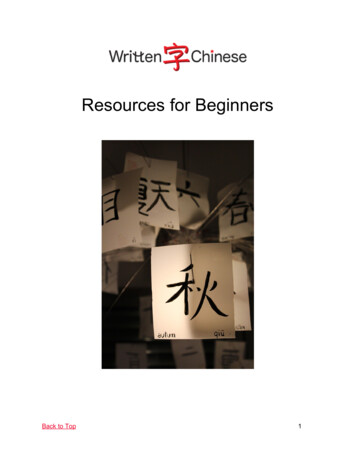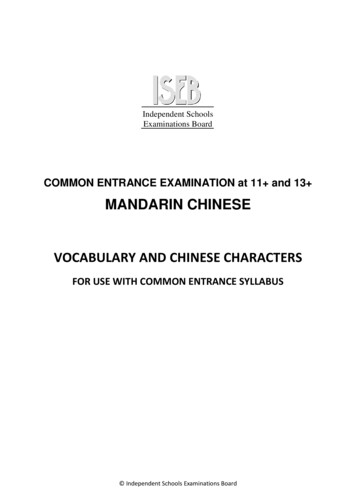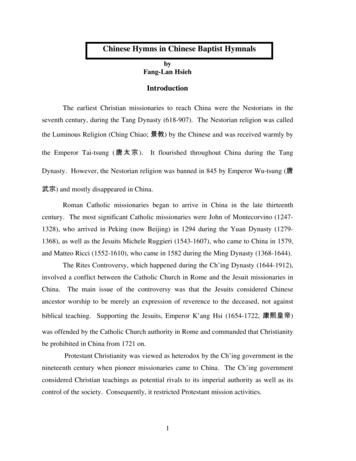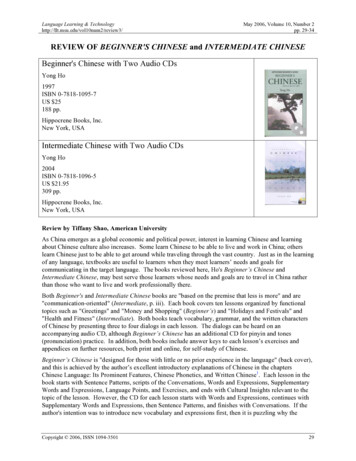
Transcription
Resources for BeginnersBack to Top 1
Contents The Definitive Guide to Pinyin & Chinese Pronunciation Pinyin Chart What’s the Best Way to Learn Chinese? Some Do’s & Don’ts from aStudent of Mandarin The Chinese Bigram: Why Learning Chinese Characters is Easier in Twos The Radical Truth: The Importance of Learning Radicals Weighing Up Measure Words Chinese Character Stroke Rules (And How To Break Them!) 10 Essential Chinese Sentence Patterns Every Beginner Should Know 20 Practical Chinese Verbs You Need to Learn You & Me. This & That: Pronouns in Chinese Resource PageBack to Top 2
The Definitive Guide to Pinyin &Chinese PronunciationPinyin: An IntroductionPinyin 拼音 (pīn yīn), is the romanized translation of Chinese characters. Pinyinwas introduced after a language reform during the 1950s , instigated by ZhouEnlai 周恩来 (zhōu ēn lái). He believed that a phonetic system was necessary inorder for people to learn how to pronounce Chinese characters. Zhou Enlaiworked alongside linguist, Zhou Youguang 周有光 (zhōu yǒu guāng) to createHanyu Pinyin 汉语拼音 (hàn yǔ pīn yīn). Hanyu (another way to say ‘Chineselanguage’) Pinyin used the Latin alphabet, which Zhou Youguang believed wouldhelp connect China to the western world.Zhou Youguang is known as the ‘Father of Pinyin’ and recently celebrated his110th birthday!Although Pinyin is based on the Latin alphabet, the sounds that are created whenletters make a word, do not sound the same as English.For example, based on our understanding that in English, the letter ‘z’ makes asound found in ‘zebra’, ‘zoo’ and ‘buzz’, and is made with the tongue at the frontof the mouth. If we look at the romanization of the Chinese city, Shenzhen 深圳(shēn zhèn), we would assume that the second word ‘zhèn’, would be spokenwith the same ‘z’ sound. However, in Pinyin, when the letters ‘z’ and ‘h’ are foundtogether, they make a sound more similar to ‘j’, as in ‘jog’ or ‘jump’.You’ve probably already noticed that Pinyin often has a mark above a vowel, andthis indicates which tone to use. A tone is a sound, that as in music is determinedby pitch and strength. It can also indicate emotions. We’ll get to the tone markersshortly, but first let’s focus on how to pronounce Pinyin.Back to Top 3
Why Pinyin is ImportantEven though Pinyin is ‘based’ on the Latin alphabet, it still needs to be learned.Many people want to skip Pinyin and go straight to Chinese characters, but thereare several reasons why learning Pinyin is essential to learning Chinese properly. The pronunciation of some Pinyin is not the same as the pronunciation of theLatin letter. There are sounds that do not exist in the English language. Pinyin also shows the tone of a Chinese character. Pinyin acts as a base for learning Chinese characters. Once you’ve learnedPinyin, you can get going with characters!You can read more about some Pros and Cons about learning Pinyin here.How to Pronounce PinyinAs I mentioned in the introduction, even though pinyin uses the Latin alphabet,the pronunciation is not the same as its romanized counterpart, and it isIMPOSSIBLE to learn Chinese without listening to it and speaking it. You cantake a look at the Pinyin chart below and see all the different sounds in theChinese language.Once you’ve learned these sounds, you’re well on the way to mastering Chinese!To learn how to read and speak Pinyin using the chart, you can do the following:1. Copy the Pinyin you want to learnBack to Top 4
2. Open a new browser tab, and open https://dictionary.writtenchinese.com3. Paste the Pinyin into the search bar, and hit ‘ENTER’ on your keyboard, or tapthe ‘magnifying glass’ search icon.4. Look at the list of words that appear, and choose an example that has the firsttone of ‘ – ’ above the pinyin.Back to Top 5
5. Press the audio button and listen to the pronunciation.You can see that the there are lots of patterns within the Chinese language. Forexample, once you understand that the pinyin ‘ao’ is pronounced like ‘ow’ (as in‘ow! That hurt!) in English, you can begin to add the consonants and make newwords.Back to Top 6
How To Read Pinyin Tone MarkersLearning to use tones is imperative if you want to speak Chinese properly. Youmay have heard that tones are not necessary, and that you can ‘get by’ just finewithout them. Infact, this is absolutely true and the reality is, that you will nevermanage fluency without them. It is far easier to learn tones right from thebeginning than to realize after 6 months of studying that you should have reallybuckled down and learned them. It’s super difficult to backtrack and learn it onceyou’re already several months (or even years) into speaking Chinese.This is especially important for those of you who are in China and ‘learning’Chinese, as it’s much easier to become complacent about doing some seriousstudying.Although the line markers are a common way to read the tone of a word, youmay also see Pinyin marked with a number and be colour coded.Both our Online Dictionary and mobile app have the function to change frommarkers to numbers and for the Pinyin to have colours or not. It’s completely yourchoice!Back to Top 7
To change the tone settings in the Written Chinese Dictionary, tap on the Menubutton and then go to Settings.The 5 Tones of Mandarin ChineseThere are 5 ‘tones’ in Mandarin Chinese. A tone 声调 ( shēng diào) refers to theway a character should be spoken. Tones can often be one of the difficult partsof learning Chinese, but the most important reason why you need to learn tones,is because pinyin tone a word. So, if either the Pinyin or tone changes, itcreates a new word.Don’t panic! It’s not as crazy as it sounds. Remember that Pinyin is just the basisof your Chinese learning. Once you’ve grasped these concepts, you can begin toBack to Top 8
introduce Chinese characters and much of what you’ve learned won’t be sointimidating!Using the Pinyin ‘ma’, the 5 tones are as follows: mā má mǎ mà maIf you click on each of the 5 ‘ma’s, you will be taken to the Online Dictionarywhere you can listen to the different tones. (Don’t forget to press the audio buttonto listen!)mā/ma1 – if a vowel has a flat line above it, the pinyin is spoken with a flat hightone. This is know as the first tone.má/ma2 – if a vowel has a upward line above it, then the pinyin is spoken with arising tone. This is known as the second tone.mǎ/ma3 – if a vowel has a ‘v’ shape above it, then the pinyin is spoken with adipped tone and this is known as the third tone.mà/ma4 – if a vowel has a downward line above it, then the pinyin is spoken witha down tone and this is known as the fourth tone.ma/ma5 – if the pinyin has no line, then the pinyin has no tone. This is known asthe fifth tone.Technically, a fifth tone pinyin does have a tone, but it is dependent on thecharacter that comes before it. As a beginner, this is something to be aware of,but not something to panic about!Test Your Tones!Once you’ve listened to the different tones, you can test yourself using our tonetrainer. Even if you’re brand new to Chinese, this can help train your ear tohearing the five different tones.Try our Tone TrainerBack to Top 9
Perfect Your Chinese PronunciationSo, now that you’ve learned the importance of Pinyin, you can make a start onusing the Pinyin Chart, to perfect your Chinese pronunciation from the verybeginning of your Chinese adventure!You can read the original article ide-to-pinyin-chinese-pronunciation/Back to Top 10
datanalagakahazacasazha zhai zhao zhan zhangcha chai chao chan changsha shai shao shan nitidimipibier yier ixirongchen chengshou she shei shen shengchong chou chezhong zhou zhe zhei shen eemou me mei men jrfafpangbangooman mang mopanbanma mai pianbianyaniantiejiaoliaojieliejiuliuniao nie niutiaodiao die diuxia xiao xiexiuyangiangtingdingmin mingpin pingjiangliangjinlinjinglingjiongxian xiang xinxing xiongqian qiang qin qing uizuihuo huikuo kuiguo guiluonuotuoduo unhuangkuangguangwen wangunruruaruoruiruanrunshu shua shuo shui shuai shuan shun shuangchu chua chuo chui chuai chuan chun chuangzhu zhua zhuo zhui zhuai zhuan zhun zhuangsucuzuhukugulunutudufumupubuying yong wu waingbin bingyininnian niang nin ningtiandianmiao mie miu mianpiao piebiao bieyaoiaoqia qiao qie qiujialiayaiaPinyin Chartüeüan ünwww.writtenchinese.comxu xue xuan xunqu que quan qunju jue juan junlü lüenü nüeweng yu yue yuan yunueng ü
What’s the Best Way to LearnChinese? Some Do’s & Don’ts from aStudent of MandarinI have to admit, I’m not the best student. I’ve been in China for a number ofyears, and I’ve learned a lot of lessons that I wish I’d known before I startedlearning Chinese.For a start, I wish I’d been more disciplined, because what I found was thatunless I actually opened my ears and listened to this language, I would neveractually learn anything.To help those of you who are maybe new to learning Chinese, are consideringstudying a new language or even just need a push in the right direction, I’vecome up with some suggested do’s and don’ts I wish I had known a long timeago. I feel as though my studying would have been smoother, more enjoyableand my Chinese would have progressed way quicker!My list obviously doesn’t need to be followed to the letter, and you probably allhave other do’s and don’ts that you would like to share with fellow learners. If youwould like to share any ideas, please share them in the comments below! Also, Iwouldn’t expect everyone to agree with my list, it’s just based on my (and myfriends/ colleagues/ and other Chinese learners) experiences, but they might notfit everyone.To keep things positive and to move forward with our Chinese learning, I’ve gotmore do’s than don’ts.Here’s my list to help you find the best way to learn Chinese:DO learn to read and writeIf I’d have known this a few years back, I wouldn’t feel like I’m now back inkindergarten learning to write ABC again. I can’t stress enough how much moreBack to Top 11
difficult it is to learn to read and write all those characters you are now able tospeak. So many people are put off from learning to read and write Chinesecharacters, including myself, because it’s ‘too hard’. Since I started learning toread and write Chinese Characters, I’m way more excited about learningChinese. That probably sounds a bit strange, but I find learning andunderstanding characters so interesting! Characters are made up of smaller‘parts’ known as radicals ( that you can read more about here ) that helpunderstand pronunciation and meaning. Although, I don’t suggesting learningcharacters as soon as you begin learning to speak, after a month or so, youcould begin to learn some basic ‘pictograph’ characters to get you started.If you’re not convinced, take a look at some other reasons why Characters aregreat !DO get a teacherI think until I got a teacher, I wasn’t disciplined enough to focus on seriouslylearning Chinese. Once I finally got a teacher, it was a bit disheartening to realizemy tones were atrociously bad and I basically had to start from scratch. Nowobviously that’s my personal experience, and I do know a lot of people who’veBack to Top 12
learned Chinese, although not fluently, without formal classes, I believe getting ateacher can really benefit your Chinese learning. Not only can they guide you inthe right direction, and give encouragement, but they’re also someone to practicespeaking with! A teacher doesn’t have to be someone who works in a schooleither, they can just be a friend or a colleague (one that speaks Chinese,obviously). On a side note, a lot of men I know here who’ve had Chinesegirlfriends, have great Chinese, although I’m not suggesting you go on the huntfor one just to improve your Mandarin!DO immerse yourself in the LanguageIf you have an opportunity to come to China to travel or teach, then take it! Noraand I record a weekly podcast where we talk about living in China, so if you’reinterested in making the move over here, have a listen! Seriously though,plonking yourself (for a short time) in a 2nd tier City here in China, is probablygonna not only improve your Chinese, but teach you some valuable lessonsabout culture and Chinese people! You might have to go without some homecomforts, but your Chinese will be great!Of course, if you can’t get to China right now, there are still plenty of ways inwhich you can become more immersed in Chinese. You can visit your nearestChinatown or local Chinese restaurant. There you can listen to them speak, tryand read the Chinese characters on the menu and even try and order your foodin Chinese. Nora strongly recommends watching game shows and reality TVshows to improve your Chinese , although movies are great too! Finally, makesome Chinese friends!DO make time to studyEven if you don’t have a lot of free time, it will really help your studies if you’reable to put time aside each day to learn some vocabulary, or do the WrittenChinese Dashboard homework . Why not use your commute to review someflashcards, or take 10 minutes of your lunch break to practice writing somecharacters. This is my current study schedule:One 1 ½ hour Chinese class per week where I might get 20 – 30 new vocabularywords for speaking and around 20 characters to learn to read and write. I thena
Student of Mandarin I have to admit, I’m not the best student. I’ve been in China for a number of years, and I’ve learned a lot of lessons that I wish I’d known before I started learning Chinese. For a start, I wish I’d been more disciplined, because what I found was that unless I actually opened my ears and listened to this language, I would never actually learn anything. To help .











